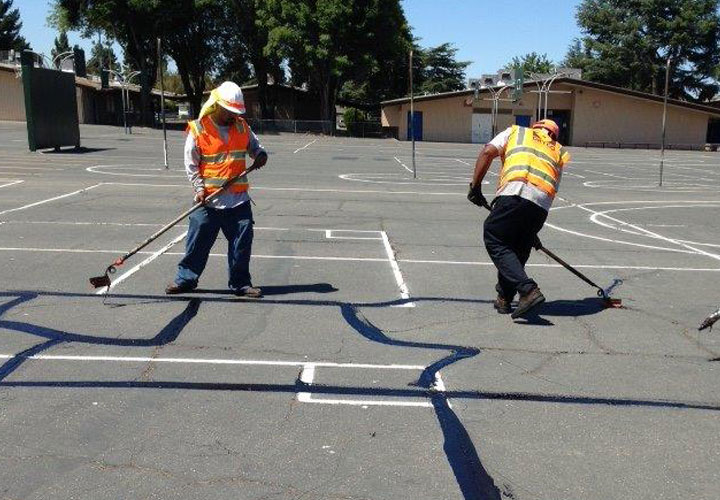Make The Most Of Investment Returns: Angled Parking Lot Excellence with Asphalt Sealing
Make The Most Of Investment Returns: Angled Parking Lot Excellence with Asphalt Sealing
Blog Article
Warm Mix Asphalt: A Sustainable Option for Sidewalk
Hot Mix Asphalt (HMA) has actually emerged as a leading lasting choice for pavement options, supplying a myriad of ecological benefits and ingenious innovations. As the demand for green building and construction methods expands, discovering the subtleties of HMA's sustainability can provide important understandings into the future of sidewalk services.
Ecological Benefits of Warm Mix Asphalt

Additionally, Hot Mix Asphalt aids to minimize city warmth island effects. Its dark color absorbs sunlight, decreasing the amount of warmth reflected back right into the ambience compared to lighter-colored sidewalks. This can decrease ambient temperature levels in metropolitan locations, lowering the need for cooling and ultimately reducing energy usage.
On top of that, Warm Mix Asphalt adds to boosted stormwater monitoring. Its porous nature enables water to infiltrate the sidewalk and reenergize groundwater products, reducing runoff and the threat of flooding. These ecological benefits make Warm Mix Asphalt a lasting selection for leading freeways and roads.
Energy Performance in HMA Manufacturing
Is power effectiveness a vital element in the manufacturing of Warm Mix Asphalt (HMA)? Energy plays a significant duty in the manufacturing of HMA, influencing both price and environmental sustainability. One crucial facet of energy performance in HMA production is the use of cozy mix asphalt (WMA) technologies.
In addition, innovations in plant innovations have brought about more energy-efficient HMA manufacturing processes. Modern plants are developed with features like recycled asphalt pavement (RAP) handling abilities, effective heater systems, and boosted insulation, all adding to power cost savings. By enhancing energy usage in HMA manufacturing, the industry can lower its carbon impact while keeping top quality sidewalk materials. Power performance is, as a result, a critical consideration in ensuring the sustainability of Hot Mix Asphalt production.
Recyclability of Hot Mix Asphalt
The recyclability of Warm Mix Asphalt (HMA) is a crucial facet of its sustainability and long-lasting ecological impact. HMA is among one of the most recycled products in the USA, with over 100 million lots of recovered asphalt sidewalk (RAP) being recycled every year in new pavement building. Recycling HMA supplies a number of environmental benefits, such as decreasing the demand for virgin materials, decreasing power intake during production, and decreasing the amount of waste sent to garbage dumps.
The procedure of reusing HMA includes grating the existing pavement, crushing it right into smaller items, and mixing it with new accumulation and asphalt binder to develop a recycled mix. Generally, the recyclability of HMA plays a significant duty in promoting sustainable techniques within the pavement sector.

Long-Term Performance of HMA
Asphalt pavements demonstrate sturdiness and strength over an extensive duration, mirroring the lasting efficiency of Hot Mix Asphalt (HMA) The longevity of HMA can be associated to its ability to withstand Resources heavy website traffic tons, extreme climate condition, and the impacts of aging. Research studies have revealed that properly designed and effectively built HMA pavements can last for 20 years or more with normal upkeep. The secret to making best use of the lasting efficiency of HMA hinges on utilizing top dig this quality materials, adhering to ideal methods in building, and executing effective upkeep methods. Proper drainage, regular evaluations, and prompt repair work are important for maintaining the structural integrity of HMA sidewalks over time. In addition, improvements in HMA technology, such as using polymer-modified binders and warm mix asphalt, have further enhanced the durability and long life of HMA sidewalks. By focusing on high quality construction and upkeep techniques, HMA continues to confirm itself as a cost-efficient and lasting option for long-lasting pavement facilities.

HMA: Resilience and Sustainability
Showing both longevity and sustainability, Warm Mix Asphalt (HMA) has actually become a foundation in the building of lasting pavement frameworks - regrading. HMA's resilience originates from its capability to withstand heavy tons, severe weather, and high website traffic volumes, making it Bonuses a reliable choice for roads, highways, and airport terminal runways. The structure of HMA, which commonly includes aggregates, binder, and filler, plays a crucial function in boosting its longevity and resistance to use and tear
Moreover, HMA's sustainability hinges on its recyclability and energy-efficient manufacturing process. The capability to recycle reclaimed asphalt pavement (RAP) in new HMA combinations reduces the need for virgin products and lessens the environmental effect of sidewalk construction and upkeep. Additionally, the power effectiveness of producing HMA depends on its reduced mixing temperature levels compared to other sidewalk products, causing decreased energy consumption and greenhouse gas discharges.
Conclusion
In verdict, warm mix asphalt (HMA) supplies a sustainable solution for sidewalk with its ecologically friendly features. HMA's recyclability, power efficiency in manufacturing, and long-term durability make it an eco-friendly selection for roadway building.
HMA is one of the most recycled materials in the United States, with over 100 million bunches of redeemed asphalt pavement (RAP) being reused annually in brand-new pavement building.The process of reusing HMA includes milling the existing sidewalk, crushing it right into smaller items, and mixing it with brand-new accumulation and asphalt binder to develop a recycled mix.Asphalt sidewalks demonstrate sturdiness and resilience over an extended duration, showing the long-term efficiency of Warm Mix Asphalt (HMA) In addition, improvements in HMA technology, such as the usage of polymer-modified binders and cozy mix asphalt, have better boosted the resilience and durability of HMA sidewalks. The capacity to recycle recovered asphalt sidewalk (RAP) in brand-new HMA mixes lowers the need for virgin materials and reduces the environmental impact of sidewalk construction and upkeep.
Report this page